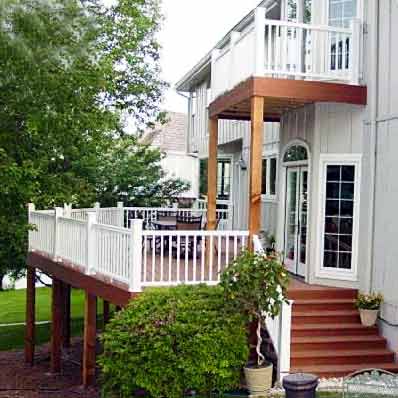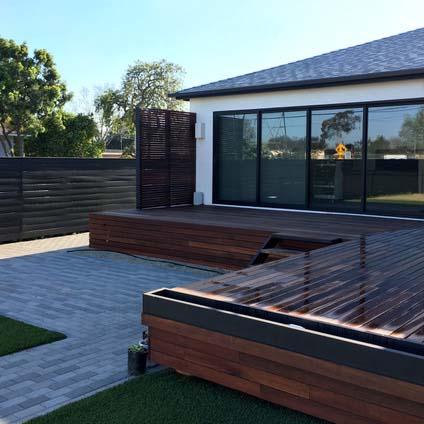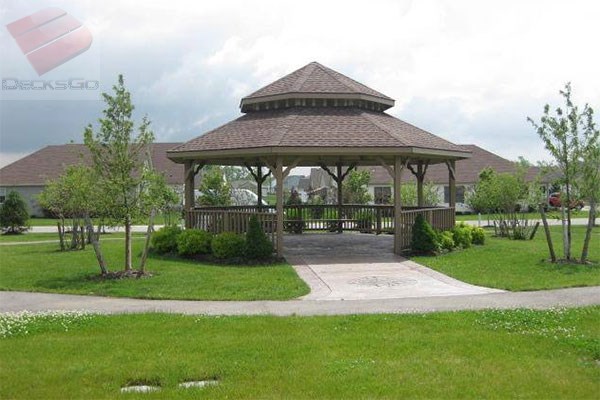Your Deck Site - Build in the Perfect Location
Where to begin? Planning where to locate your deck is one of the very first and most important steps you must take.
Where you position your deck? How high it will be? What purpose your deck will be used for and at what times during the day?
Where the sun will be, and where prevailing winds come from are some of the more important issues you should consider and will influence your final decision.
Below are some of the more common factors that you should consider before you start building your deck.
Inspect Your Site
The first thing you should do is walk around your site and observe the physical characteristics of the land. Note the slope away from the house.
Where is the natural drainage located? Are there downspouts near where your deck will be? If so, is the drainage working properly to take the water away from the house foundation and deck footings?
What about trees, rocks, electrical boxes and other physical features. How close is the next property to you?
Where are the exterior electrical or gas outlets located? You may want to incorporate them with your deck.

Refer to these notes when you draft your plan
Is there a septic tank or field below where your deck footings will go? Where is the midday sun? Take a few photos with your digital camera so you don’t forget these little things once you start to draw up a plan.
Now consider the non-physical aspects such as any local building restrictions that may apply to your proposed deck such as covenants, easements, and underground utility lines that may be present.
Draw all of these observations on a note pad in relation to the perimeter of the house. Mark the doors, windows and rooms of the house so you have a context when you look at the diagram. Mark the north direction as well. At the bottom of the pad, write out your comments about easements, zoning restrictions or anything else that you don’t want to forget.
Elevation
Pay special attention to the topography of your deck site. If you are lucky enough to be building your deck on a flat site, then you can ignore this section. Otherwise, draw an elevation (side) view of your house, the land and the proposed deck level to get an idea of the elevation change and height of posts you will need.
Elevation offers an opportunity for very exciting deck design possibilities depending on the other following factors. You may be able to incorporate some nice level changes to break up the deck. You may also have to consider breaking up your stairway to account for the height differences. This may mean building landings for deck stairs.
Sometimes having the main living portion of your deck at a very high elevation is not desirable because it is too visible to neighbors. If this is an issue for you, now is the time to design your deck to address that problem. Perhaps a small landing from your patio door leading to a set of stairs that land on a lower deck is your solution.
Privacy/Proximity of Neighbors
Are you in a tightly packed suburb or are you living on a ranch looking west to the majestic Rocky Mountains? Your situation will dictate the degree of privacy you may want. If you live close to neighbors, you may want to consider deck railings that extend higher and have some kind of a privacy panel to make your deck cozier. Privacy can be created by placing potted plants and even small shrubs or trees alongside railing to achieve a very natural barrier.
If you don’t have neighbors near by then it doesn’t matter if your deck is protruding high above the ground and seen from afar. In fact you would probably want to consider taking full advantage of that.

Orientation to Sun
This is certainly one of the most important factors to consider in planning your deck location. Depending on your latitude (how far north or south you are from the equator) exposing your deck directly to the midday sun may or may not be a good thing. The further north you are, the more you should be willing to expose your deck to the sun during the hotter periods of the day. The opposite is true for more southern locales.
You can achieve a compromise by making your deck wrap around the corner of a house. This may give you the best of both worlds.
As a rule consider these optimum locations for North or South regions:
North:
The ideal location is a south east or south west location to take advantage of midday sun and evening sun to the west. You generally want to maximize the heat from the sun.
South:
The ideal location is a north east or north west location to minimize the extreme midday heat but still take advantage of the early morning and late setting sun which is less intense but still offers sufficient warmth.
If your deck can’t avoid direct exposure to the sun, consider incorporating an overhead trellis, awning or other roof structure to offer some shade over the deck.

Climate
We have already partially explained the importance of knowing your climate zone in the previous section about orientation of the sun. Simply stated, the farther south you are, the higher the sun is in the sky and the more powerful the rays are. The following diagrams illustrate both the climate zones of North America and the angle of the sun on a typical deck.
Wind
Don’t forget to consider the direction of prevailing winds if you live in an area where this is a concern. A strong prevailing wind will influence where you decide to locate your deck. If you can’t avoid the wind you should consider a railing that acts as a barrier to the wind. It would also serve as a privacy screen.
View
Ask yourself if you deck is well positioned to take advantage of any views. This is more common in rural or semi-rural areas especially if your deck is located on an elevation. Views ought to be taken advantage of because they can be breath taking and the focal point of a home.
Home > Planning & Design > Deck Site


























